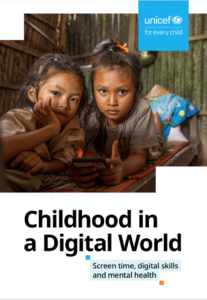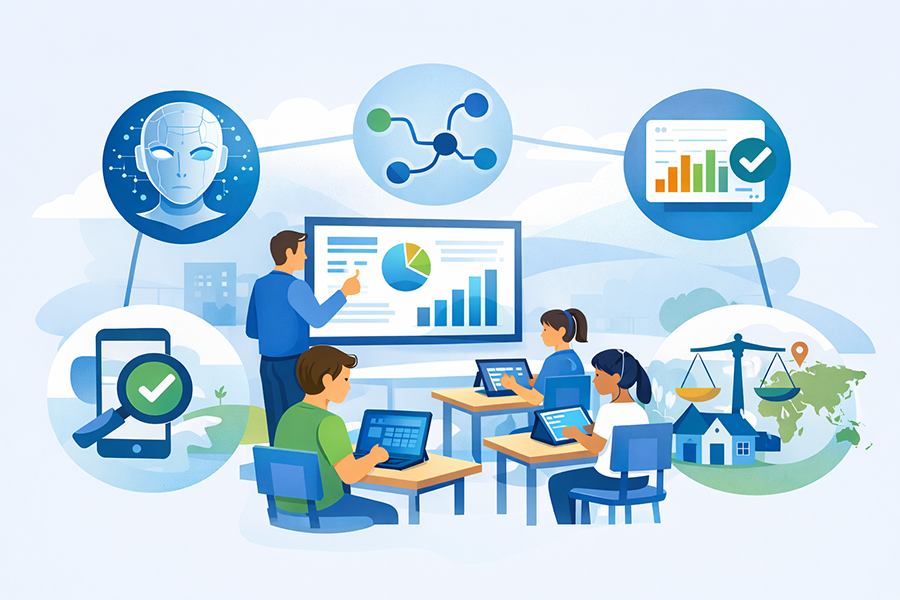We are surrounded by headlines about digital transformation, classrooms of the future, and children coding from cradle to grave. But beyond the noise, reality asserts itself stubbornly: in much of the world, school digitalisation has barely begun. And where it has arrived, it hasn’t always been implemented well. The digital divide is not a matter of science fiction or Silicon Valley; it is an urgent, everyday, and above all profoundly unequal educational issue.

According to data from UNICEF’s latest report (Childhood in a Digital World, 2025), 95 per cent of pupils in OECD countries have internet access at school. However, less than half use it daily in the classroom. And only 30 per cent frequently use computers or laptops. In other words: access exists, but meaningful educational use does not. Put less technically: there is connection, but no transformation.
Meanwhile, two in three children worldwide still lack internet access at home. In many cases, school is their only window to the digital world. If the technology in that school simply sits unused in a corner, little can be expected. If it’s switched on but no one knows how to use it properly, that too is futile.
The paradox is clear. While in affluent countries there is debate over children spending too much time in front of screens, in much of the globe, children lack screens, time or conditions to learn how to use them. Meanwhile, the world—and the job market—advance by leaps and bounds powered by algorithms. Those who don’t join in time will be left behind.
This article does not claim to uncover a revolutionary truth. But it does remind us of something all too often overlooked: the heart of any educational innovation lies not in the technology, but in those who teach its use. In the most vulnerable schools, this equates to a clear commitment: invest in teachers so they can act as digital equalisers. After all, a good internet connection is worthless if there isn’t someone on the other end who knows what it’s for.
The digital divide in schools: access is not the same as use
During the worst months of the pandemic, many governments rushed to speak of “pedagogical continuity” through digital platforms. The enthusiasm for virtual classes lasted only until an inconvenient truth became apparent: millions of pupils simply could not log on. They had no computers, no data, often no electricity. Some didn’t even have a desk to study at. The emergency brought to light a reality that already existed, but which many had preferred to ignore.
Today, four years later, the situation has improved in certain respects. Most middle- and high-income nations have invested in connecting schools. According to the UNICEF report, 95 per cent of pupils in OECD countries say they have internet access at their educational institution. The figure is impressive—if one does not delve into the details.
Because of that 95 per cent, fewer than half—48 per cent—use the internet daily at school. And barely 30 per cent use computers or laptops every day. The rest of the time, the technology is there, present but silent. What exists is not always utilised—or no one knows how to use it—or it’s not integrated into the pedagogical routine. It’s the digital equivalent of a library with no open books.
This disconnect between infrastructure and effective use is not anecdotal. It is structural. According to the same report, 20 per cent of pupils in wealthy countries seldom or never use the internet in class. And 25 per cent nearly never touch a computer. We’re not referring to rural areas with difficult access, but equipped schools. The problem, as so often in education, is not just about resources, but about purpose.
What the report suggests—and what many on-the-ground experiences confirm—is that the digital divide is no longer only about cables, but about pedagogy: how teaching is done, who teaches, and what is considered valuable to learn. Simply filling classrooms with devices isn’t enough if they’re not accompanied by a clear educational plan, time for teachers, ongoing training, and above all, belief in the value of teaching in a digital world.
Schools, especially in vulnerable contexts, could be key spaces to compensate for digital access inequalities. But this requires more than infrastructure. It requires vision. And it demands a central actor often overlooked in official rhetoric: the teacher.
The teacher as a digital equaliser
In discussions on educational innovation, the teacher often plays a secondary role. There is talk of platforms, algorithms, artificial intelligence. Pilot programmes, distributed devices, apps with lofty names are celebrated. But rarely is attention paid to the one who must implement all this day after day: the teacher. Without them, no transformation truly matters.
The UNICEF report is clear. Having devices and internet access does not guarantee that children develop digital skills. What makes the difference is how they use the technology. And that usage is heavily conditioned by pedagogical mediation. In other words: whether a computer becomes a learning tool or a decorative object depends on the teacher.
In vulnerable areas—where two in three children lack internet access at home—the school can be the only gateway to the digital world. There, the teacher’s role becomes even more crucial: not only must they teach content, but also foster skills for digital life. How to search for information, identify reliable sources, manage privacy, and protect oneself from risks. Skills that don’t develop by osmosis, but with guidance.
The data also show that pupils build more skills when they engage in a variety of online activities. But that variety doesn’t occur by chance: it requires guidance, didactic design and pedagogical intent. The report cites that children who do more online—playing, creating, researching—have better digital competences, even when their screen time is identical.
The paradox is that, in many schooling systems, teachers are expected to integrate technology without adequate training. They are handed a digital whiteboard without being told what it’s for. They’re asked to innovate without reducing their administrative load or class size. Sometimes they are not even consulted. And then they are held responsible for poor results.
The report’s recommendation is clear: teacher training must be a priority in any digital inclusion policy. Distributing devices is insufficient if you don’t simultaneously invest in strengthening the capabilities of those who will make them meaningful in the classroom. And that investment cannot rely solely on the teacher’s own will or sporadic training initiatives. It must be part of a coherent, sustained public policy.
Until that central role is recognised, we will continue to connect schools without transforming realities. And what could be a tool of equity may risk becoming another source of exclusion.
The heart of any educational innovation lies not in the technology, but in those who teach its use.
Technology with purpose: teaching skills for the digital world
Discussing digital skills is not merely about knowing how to open an app or send an email. It refers to essential competencies for navigating an environment that is no longer parallel to the real world, but an inseparable part of it. For many children, the digital realm isn’t an extra: it is where they learn, play, relate and get informed. Thus, teaching students digital skills isn’t a modern pedagogical choice, but a fundamental educational necessity.
UNICEF identifies vital skills in this context: changing privacy settings, verifying the trustworthiness of websites, selecting effective keywords for searching, and removing unwanted contacts. Also valued is the ability to create digital content such as music or video. These are not frivolous; they are directly linked to children’s ability to seize opportunities, avoid risks, and develop as digital citizens.
The report offers revealing data: children who frequently use social media are up to twice as likely to adjust their privacy settings. They also have a 50 per cent higher chance of knowing how to remove contacts or use efficient search terms. In 16 of 25 countries studied, there was a clear link between frequent social media use and higher digital skill development, especially regarding security and critical browsing.
Time online also matters. In 29 of 31 countries analysed, children spending more time online developed significantly higher digital skills. But more relevant is the diversity of activities they perform: watching videos, playing online, creating content—all are positive factors. The number of digital activities explains between 2 per cent and 17 per cent of skill variance, depending on the country. This link is particularly strong in Africa and Asia.
In contrast, parental restrictions on internet use are linked with lower skill levels. In 21 of 22 countries with available data, children whose internet time or activities are limited scored lower in digital competences. Over-control, even if well-intentioned, may leave children more exposed, not less.
This raises an educational dilemma: protect without disconnecting. The report also dispels one major current myth: there is no solid evidence that screen time alone harms children’s mental health. Negative effects are more clearly tied to harmful content or abusive experiences—not merely hours spent in front of a screen.
Conclusion: the focus must shift from forbidding to guiding, from restricting to educating. That means rethinking curricula, integrating digital education across the board, and training teachers in these skills. Not as an add-on, but as a central component of 21st-century citizenship education.
Because if school doesn’t teach children to inhabit the digital world with critical thought and safety, then platforms, algorithms and the market will do so—without asking permission.
The question no one asks
While the world debates whether children should learn programming at eight or if TikTok should be banned until sixteen, one rarely asked question needs addressing: who is teaching them to be humans in the digital world?
This is not a technical question. It is deeply political. Because the digital future isn’t defined by the number of devices, but by who has the tools to use them meaningfully, consciously, and with agency. And in that equation, the teacher’s role is irreplaceable.
Today, the risk isn’t just that many children will be excluded from internet access. It’s that even those who are connected might grow up without the critical perspective or protection a humanistic digital education provides. Algorithms don’t educate—they amplify. They reinforce biases, encourage consumption, reward noise. Without pedagogical oversight that questions, checks and teaches how to interpret them, we’re not educating; we’re exposing.
UNICEF makes clear that real harm comes not from screen time, but from content and context. Yet many public policies remain focused on restriction rather than education. It is easier to count internet hours than to teach a generation digital citizenship.
In the most vulnerable contexts, a trained and committed teacher can make the difference between a life of opportunity and a perpetuated divide.
Of all possible innovations, perhaps the most urgent isn’t technical, but pedagogical: recognising that the greatest engine of digital inclusion remains the relationship between teacher and student. Because no app—even the most advanced—nor AI—no matter how sophisticated—has so far been able to teach with empathy, care and humanity.
And in these times of meaningless hyper-connectivity, that is a revolutionary act.






